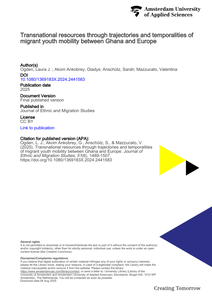Research on migrant youth makes two longstanding assumptions: that they are immobile following their own or their parents’ migration and that their resource environments are confined to their country of residence. Recent investigations of transnational youth mobility question both assumptions, showing that migrant youth – including the first and second generations – are highly mobile, and that their mobility has multiple impacts on their lives. This paper seeks to add to this growing literature by conceptualising as ‘transnational resources’ the perspectives, values, knowledge, and skills that migrant youth gain from their mobility between their countries of origin and residence and which become meaningful in various aspects of their multi-local (or what we call transnational) lives. Drawing on ethnographic data with 81 young people who are mobile between Ghana and three European countries (Belgium, Germany, and the Netherlands), we analyse the three main transnational resources we identified – enhanced sense of self, adaptability, and future outlook. Engaging the dual analytical lenses of temporalities and trajectories, we show both how transnational resources are gained through embodied mobility experiences and how they become meaningful in migrant youth’s lives across time and space.
DOCUMENT

Transcript of a lecture during the conference 'Is contemporary art history', Institute of Fine Arts, New York, 28th february 2014.
MULTIFILE
The present social and environmental challenges, the impact of climate change andthe pandemic, revealed the urgency and the opportunity to rethink urban designthrough its renewed spaces and temporalities. The pandemic offered a ‘natural exper-iment’ to explore and develop new perspectives, making public spaces more resilient.Contributing towards a rethink of these spaces, the present paper explores adaptivearchitecture with responsive technologies and their capability of shaping public spacesto constitute a conversation piece with the surrounding environment. This approachcombines and reflects different disciplinary fields: architecture, civic interaction and ur-ban design. The exploration works around a speculative design case – produced aspart of broader research at the Amsterdam University of Applied Science in collabora-tion with the Master in Digital Design.
DOCUMENT
